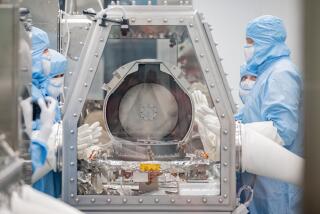NASA’s Collection of ‘Stardust’ Falls Flat
- Share via
DUGWAY PROVING GROUND, Utah — NASA’s Genesis space capsule, which scientists had hoped would return to Earth with clues about the origin of the solar system, crashed into the brown Utah salt flats Wednesday after its parachute failed to open.
NASA had planned to gently bring the specimens back with a pillow-soft landing using a helicopter to snag the capsule’s parachute.
Inside the capsule was a delicate cargo of 0.4 milligrams of oxygen, nitrogen and other particles blown by the solar wind -- about a billion-billion atoms that the craft collected during its three years in space.
“This is sickening,” said Roger Weins, a scientist at Los Alamos National Laboratory who had been working on the project for 14 years.
Project officials had high hopes for the $264-million mission, the first to bring a sample back from space since the 1970s, when NASA’s Apollo missions and the Soviet Luna explorations brought back chunks of the moon.
But the optimism of Genesis’ scientists and engineers turned to disappointment soon after observers saw the first white speck of the capsule on a large screen inside a hangar at the Army’s Dugway complex about 8:55 a.m.
Weins started to look worried when he saw the capsule wobbling. His face fell when a mission control dispatcher announced a few minutes later: “We do not see a drogue,” referring to the small parachute that was supposed to slow the craft.
Then came the word: “Impacted.”
The capsule hit the ground at 193 mph and wedged itself halfway in the mud 31 miles west of the hangar where scientists and engineers watched the return, project officials said.
The outer shell cracked open like an oyster, exposing the science canister, which held five pizza-sized collector plates and a concentrator instrument. The canister’s lid was pried open.
“The samples themselves are exposed to the air,” said Don Sweetnam, the project manager based at the Jet Propulsion Laboratory in Pasadena.
NASA officials said they were trying to understand what happened since the capsule seemed to be on course for a perfect reentry in the heart of its elliptical target zone.
NASA said a mishap investigation team would be assembled in the next 72 hours.
“It’s not been a very good day,” said Caltech professor Don Burnett, the mission’s principal investigator. “We’ll do the best we can.”
Bob Corwin, the recovery team chief for Lockheed Martin Corp., which built the return capsule, said he did not know what went wrong, but surmised a possible malfunction of the craft’s parachute battery or the electronics controlling the chute.
Sweetnam, who has been involved in the project since 1997, was trying to stay optimistic. “This was not the worst-case scenario,” he said. “The worst-case scenario was that it burned in the atmosphere and nothing came back.”
The Genesis mission was designed to probe one of the most basic mysteries of our solar system: How did it come to be?
The solar system was created out of a homogenous cloud of interstellar gas, dust and ice known as the solar nebula. Gradually, these pieces came together to form planets, moons, asteroids and comets.
Scientists are not sure what made up with interstellar material, but they think the solar winds streaming out from the sun have preserved the original cloud of dust and gas.
Genesis collected this “stardust” on five plates made of ultra-pure silicon, sapphire and other materials.
The plates were so delicate that even a normal parachute landing could severely damage the samples collected in space.
NASA came up with the plan to catch the capsule’s parachute with a helicopter, recruiting two Hollywood stunt pilots to execute the maneuver.
They never got the chance to try.
At midday Wednesday, recovery teams approached the Genesis wreckage slowly. They wore respirators because they worried that the craft’s battery had been crushed and might be giving off sulfur dioxide fumes. They also worried about unexploded pyrotechnic charges, which were supposed to set off the drogue and main parafoil.
Crews recovered the science canister, bundled it like a hamburger in an aluminized plastic tarp and sent it via helicopter about 4:30 p.m. to a clean room at the Dugway complex.
Scientists and engineers used tweezers to pick dirt off the mashed canister. The remains of the sample plates will probably be sent within a week to the Johnson Space Center in Houston for the formidable task of decontaminating the wafers.
Because the atoms have embedded themselves shallowly in the lattices of these elements, the work must be done very carefully, said Don Sevilla, leader of the payload recovery team. The process could take months.
Scientists said that wafers on each of the five collector arrays had different thicknesses, which should help them put together the jigsaw puzzle.
Carlton C. Allen, astro-material curator at Johnson Space Center, expressed hope that Genesis’ samples could still be recovered.
“The atoms that it collected are not destroyed,” he said. “The collectors are broken but they’re not beyond hope. Our people have a tremendous challenge over the next couple of years now to put these things back together in a way that we can extract good science.”
More to Read
Sign up for Essential California
The most important California stories and recommendations in your inbox every morning.
You may occasionally receive promotional content from the Los Angeles Times.










